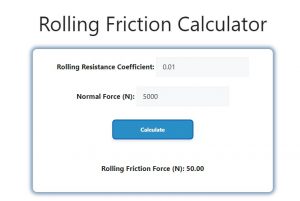About Rolling Friction Calculator (Formula)
Rolling friction, also known as rolling resistance, is a force that opposes the motion of a rolling object over a surface. It’s essential in various engineering and physics applications, such as tire performance, conveyor belts, and wheel mechanics. A Rolling Friction Calculator helps in determining this force using a simple formula.
Formula
The formula for rolling friction is: Froll = Crr * N
Where:
- Froll is the rolling friction force
- Crr is the coefficient of rolling resistance
- N is the normal force (the force perpendicular to the surface)
How to Use
To use the Rolling Friction Calculator:
- Determine the Coefficient of Rolling Resistance (Crr): This value depends on the materials of both the rolling object and the surface. You can find standard values of Crr for different materials or calculate it through experiments.
- Measure the Normal Force (N): The normal force is the weight of the object or the force exerted perpendicular to the rolling surface.
- Input the Values into the Calculator: Plug the values of Crr and N into the calculator, which will compute the rolling friction force.
Example
Imagine you’re trying to calculate the rolling friction for a car tire with a coefficient of rolling resistance (Crr) of 0.01 and a normal force (N) of 5000 N (which is approximately the weight the tire exerts on the ground). Using the formula: Froll = Crr * N
Froll = 0.01 * 5000
Froll = 50 N
So, the rolling friction force acting on the tire is 50 N.

FAQs
- What is rolling friction?
Rolling friction is the force that resists the motion of a rolling object on a surface. - How is rolling friction different from sliding friction?
Rolling friction occurs when an object rolls, while sliding friction occurs when an object slides over a surface. Rolling friction is generally much smaller than sliding friction. - What factors affect rolling friction?
Factors include the coefficient of rolling resistance, the normal force, the material properties of both the object and the surface, and the object’s speed. - What is the coefficient of rolling resistance (Crr)?
Crr is a dimensionless number that represents how much resistance a rolling object experiences on a surface. - Can the Rolling Friction Calculator be used for all objects?
Yes, it can be used for any rolling object, as long as you have the necessary data, such as Crr and normal force. - What are typical values of Crr?
Values of Crr vary depending on the material, but for rubber tires on asphalt, it ranges from 0.01 to 0.015. - Does rolling friction change with speed?
Rolling friction is relatively constant at low speeds but can increase at higher speeds due to other factors like aerodynamic drag. - How do I reduce rolling friction?
Rolling friction can be reduced by using harder surfaces, minimizing surface deformations, or using materials with a lower Crr. - Why is rolling friction important for vehicle performance?
Rolling friction directly affects fuel efficiency and tire wear in vehicles. Lower rolling friction leads to better fuel economy. - Can I calculate rolling friction for non-circular objects?
Rolling friction is typically calculated for circular objects like wheels and balls. For irregular objects, other methods may be needed. - What units are used in the formula for rolling friction?
The normal force (N) is measured in newtons (N), and the coefficient of rolling resistance (Crr) is dimensionless. - Can rolling friction be negative?
No, rolling friction cannot be negative as it always opposes the direction of motion. - How do different surfaces affect rolling friction?
Rough surfaces generally have higher rolling friction, while smooth and hard surfaces reduce it. - Is rolling friction applicable in space?
In space, there’s no surface to roll on, so rolling friction doesn’t apply in a vacuum environment. - What industries rely on rolling friction calculations?
Industries such as automotive, transportation, robotics, and material handling depend on rolling friction calculations for efficiency and design optimization.
Conclusion
Understanding rolling friction and how to calculate it using the Rolling Friction Calculator is crucial for optimizing mechanical systems that involve rolling motion. By applying the formula Froll = Crr * N, you can determine the rolling resistance, which plays a significant role in various applications from tire performance to conveyor systems.